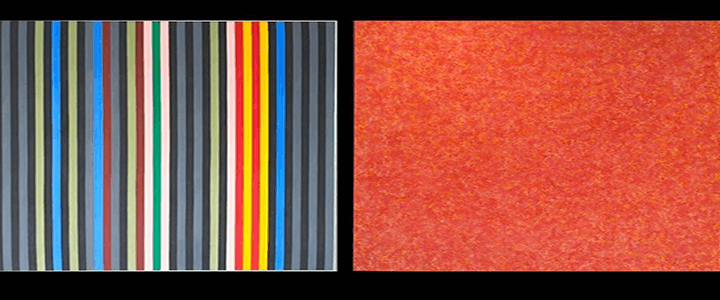Have you heard about the CIA’s secret art collection, which contains encoded arrays of color hiding messages to agents in foreign lands who could only decipher the code with some sort of rose colored glasses? Neither had I. But, when Joby Barron discovered the art, she went after the truth. D.C. artist Barbara Januszkiewicz picked up where Barron’s trail went cold and further pursued the truth about CIA’s mysterious collection of avant-garde art to the bitter end. Januszkiewicz was convinced that the truth was out there. “It just takes more than a FOIA request to find it.”
Indeed, when a FOIA request doesn’t work, try calling CIA’s Office of Public Affairs.
CHASING JUSTICE
A few details of the super-secret collection of art—along with heavily redacted documents related to the pieces—ended up on the walls of San Francisco’s Contemporary Jewish Museum. Artist and sleuth Joby Barron of Oregon inadvertently discovered the mysterious CIA art collection when she saw a few examples of CIA’s abstracts. But the CIA wasn’t talking. Their website was tortuously tantalizing. It showed only two examples of their collection by Washington, D.C. art aficionado Vincent Melzac, “catfish farm owner, salon chain magnate, Arabian race horse breeder, and former Corcoran Gallery chief.” The more Barron tried to find out what was behind the art, the more the CIA stalled, trying to throw her off the trail.
Ultimately, Barron determined to blow the cover on CIA’s secret art with her show in San Francisco called Chasing Justice that, in her mind, would “’illustrate the FOIA’s ineffectiveness, and what she called the CIA’s “knee-jerk lack of transparency’ . . . ” and “apparent obfuscation of the Melzac Collection.” Barron could have just called CIA’s Office of Public Affairs.
ISIS AND ART
Why did the Public Affairs Office open CIA’s doors to Januszkiewicz while the FOIA Office shunned Barron? CIA spokesperson Glenn Miller explains that “the FOIA office is separate from Public Affairs. ‘If an artist contacted us and wanted to come in and photograph the collection, we’d be willing to bring them in.’” Oh.
It turns out that the secret CIA art collection—allegedly acquired, in part, to fit the style of the 1961 headquarters building—is composed of 29 probably pieces representing Washington’s Color School. The CIA explains, “Every day, Agency employees walk past several abstract paintings that hang throughout the Headquarters buildings. These 29 paintings do not just break up the acres of wall space. They represent an elemental approach to art, a swashbuckling donor, and a connection to the architecture of the [Original Headquarters Building].”
But the abstract art once served a more nefarious purpose. Former director of the CIA Museum Carolyn Reams explains, “[The paintings] are used for training purposes . . . . We’ll have some of our guys and gals come down here and do a critical analysis of the paintings. Say you’ve got to analyze this big, heavy duty ISIL problem over here — maybe if you come look at the painting, it’ll help you think about how to solve the ISIL problem creatively.’”
THERE’S MORE
Victor Melzac was more than a mild-mannered D.C. based Arabian horse breeder. Melzac had strong ties to the political community, and he understood how “the Washington Color School’s clean lines constituted a pro-American aesthetic,” and they all believed that the art played a contributing role to subtly, perhaps subconsciously, undermining communism’s base of power: “the striped, polka-dotted canvases in the CIA’s halls are more than just ‘zestful’ decor — they indirectly symbolize the use of abstract art as Cold War propaganda.” Thus, when CIA looked to buy, Melzac was willing to sell to the agency.
By the way, there aren’t any secret messages hidden in the art, save but for those inaccessible messages abstract art usually communicates. Still, exercise your intelligence analysis skills the next time you see some Jackson Pollock painting plastered on the wall.
Maybe, just maybe, you’ll crack the code that defeats ISIS.




